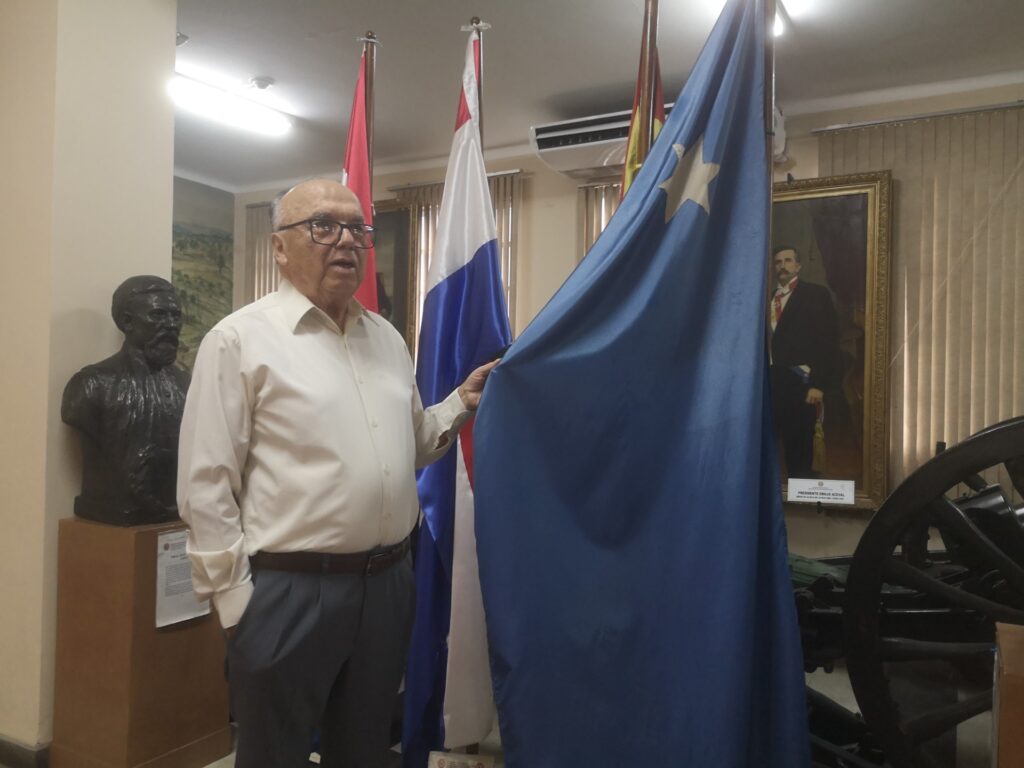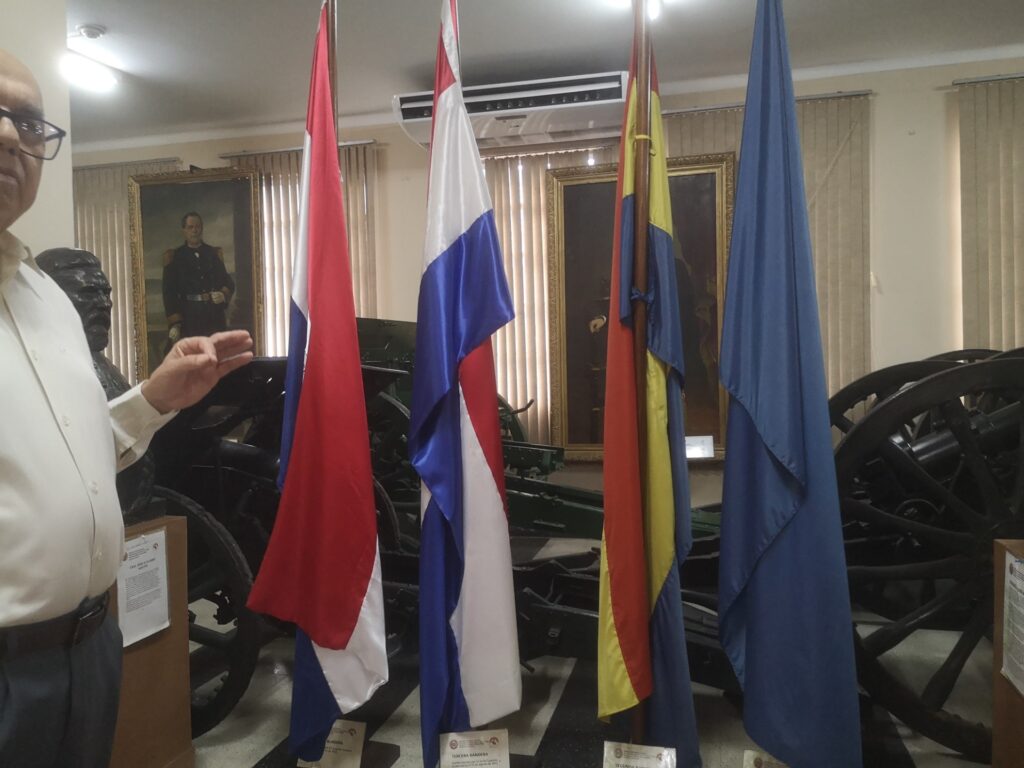Today, 14th August, is Paraguay Flag Day! It’s a tradition that dates back to 1913, and celebrates the uniqueness of Paraguay’s special national flag.
Why is it so special? Well, the Paraguayan flag is the only flag in the world with a different design on the front and back. There are other countries, such as the Republic of Moldova, where the coat of arms on the front and back of the flag are mirrored, but Paraguay is the only country where the design itself is different on both sides.
The flag of Paraguay is a horizontal tricolour of red, white and blue – specifically “French blue”. On the obverse of the flag shows the national coat of arms, and the reverse shows the seal of the treasury.
In 1913, the Teachers’ Association requested that 14 August be declared Paraguayan Flag Day so that it would not conflict with the Anniversary of the Foundation of Asunción (15 August), and the proposal was accepted for that year. Every year since then, Paraguayans celebrate the history and significance of the national flag.
Locals celebrate with official ceremonies in government institutions, schools and military bases across the country. In local schools, it is common that the students to participate in activities that teach the history of the flag and its meaning. These might include presentations, essays, art projects, and discussions about Paraguay’s history and the evolution of the national flag.
Four flags of Paraguay
Since the independence of the country, and throughout its history, Paraguay has had four flags that have embodied the colours and symbols that identify Paraguayan people. The current flag design has been in force since November 1842.
Mr. Ramon Ayala Arguello, from the Military Museum of the Ministry of Defence, talked Kaori Kurita from The Asunción Times through the history of Paraguay’s flags.
1. The first blue flag

After Paraguay’s independence in 15 May 1811, the first flag used was blue with a white star in the upper left corner. This initial all-blue design symbolised loyalty and devotion to the Virgin Mary of the Assumption (Virgen María de la Asunción), the country’s capital name.
Mr. Arguello tells us that the six-pointed star, also known as the Star of David, is an important symbol of Judaism.
2. The second flag and Spanish influence

Shortly afterwards, on 17 June 1811, during the first General Congress and once the Government had been established, it was decided to change the flag. This time, the flag was composed of three stripes of red, yellow and blue. The first two colours were taken from the Spanish flag and the blue added symbolised independence.
In the centre of the flag was also used the coat of arms of the Treasury of the Kings of Castile, which showed a certain continuity with the colonial past, but at the same time marked a transition towards a new national identity.
“This coat of arms, used by the kings of Castile, was an emblem of monarchical power and authority, but in the Paraguayan context, it began to be reinterpreted as a symbol of independence and self-determination,” said Mr. Arguello.
This new flag flew in Paraguay until 15 August 1812.
3. The third flag inspired from the flag of France

On the 15th of August 1812, the Junta de Gobierno (Governing Board) decided to make a third flag, the basis of the current one, in which the yellow was replaced by a wider white stripe in the centre.
The red, white and blue flag, which resembles the flag of the Netherlands, was actually inspired by the French flag. Mr. Ramon tells us that “France was a great admirer of the principles of liberty, equality, and fraternity promoted by the French revolutionaries, and the tricolour flag was a tribute to those ideals.”
4. The Flag Today
In 25 November 1842, an extraordinary congress held during the consulship of Carlos Antonio Lopez and Mariano Roque Alonso established the flag design that remains in use today. The flag consists of three horizontal stripes of red, white and blue, with red representing justice, white representing peace and blue representing freedom.

In the centre of the front of the flag is the national coat of arms of Paraguay with a yellow star surrounded by palm and olive leaves tied with ribbons and capped the name of the country (REPUBLICA DEL PARAGUAY).
In the centre of the reverse side of the flag is the seal of the treasury, with a lion guarding the Phrygian cap, symbol of liberation from slavery to freedom, surrounded by the words peace and justice (PAZ Y JUSTICIA).
National Pride and Symbolism Today
The Paraguayan flag, like the flags of other countries, represents pride and symbolism for the people living there.
The Paraguayan composer Mauricio Cardozo Ocampos dedicated the music “Qué linda es mi bandera” (my flag is so beautiful), which he wrote himself, a song containing 7 verses to the Paraguayan flag, which is the most well-known and is taught about and learned in schools and colleges across the country.
In addition, three streets in downtown Asunción have been named Palma Street, Estrella Street and Oliva Street after the national flag emblem, further demonstrating the importance of the flag in Paraguay’s national identity. Palma street hosts the centre-point of Asunción – “Punto Cero” – the precise point from where every other place in the country is measured from, in terms of distance from Asunción.
The Ministry of Defense Museum in Asunción showcases the four flags of Paraguay and it’s history. Exhibits also includes the historical events of the country such as the Chaco War.
Information about the Ministry of Defense Museum in Asunción:
Opening times: 7am to 3pm Monday to Friday (closed on public holidays)
Cost to enter: Free
Bring: Your identity document (Cedula de Identidad or Passport)



so interesting! very much needed to understand more about our culture